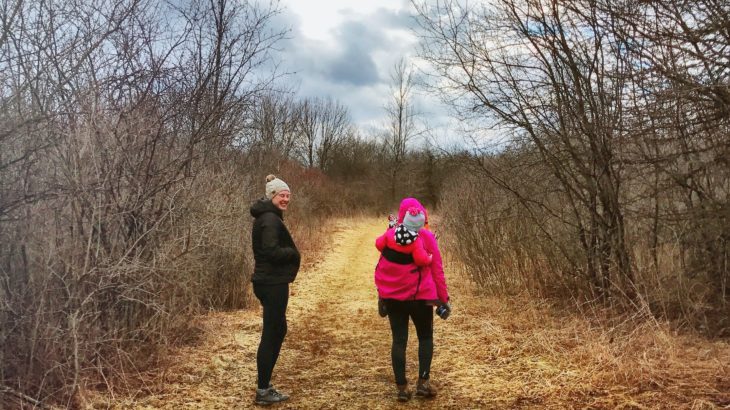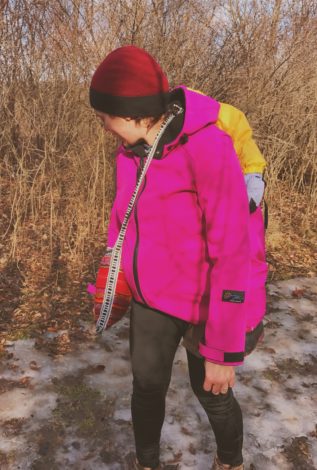Review: Wanderling 4-in-1 Jacket
 Chris, Amy's husband, told me,
Chris, Amy's husband, told me,
"When Dylan, our girl, was a baby my wife got really into “babywearing”. Amy bought an Ergobaby carrier and carried our sweet baby where ever she would go. Living in Colorado, that presented some complications. Colorado is cold, even in the summer. She started to look into buying a jacket to protect Dylan from the elements while riding in the Ergo. At first she wore my jackets and found that they were not at all comfortable for her or Dylan. She tried several jackets and carriers that just didn’t work the way she thought they should. After our third child, Weston, was born she decided to sew her own jacket at home. She designed a jacket that had a zipper down the front and a zipper down the back. The jacket also had a removable panel that can be added in the front when she wanted to front carry and then in the back when she wanted to carry Dylan on her back. The same jacket could be worn while pregnant with the panel in the front. When removing the panel all together she could wear the jacket and always feel comfortable. "
Amy has designed a truly reversible jacket to wear a little one or while pregnant. Inspired by the Colorado Rocky Mountains, Amy made the jacket from all weather fabric so it provides an impenetrable layer to prevent water and wind coming in, while still being breathable.Removable Panel
The reason this jacket works so well is the removable panel. It's easy to zip the panel into the front or onto the back depending on what kind of carry I want to use. Since the panel is generously sized, I was able to carry my toddler and my friend Erin was able to carry her toddler while pregnant. Amy designed the zippers to have long pulls so it was easy to pull the panel up higher on my back when Sky was situated. The panel zips quickly onto the front or back, and all the zippers only go one way to make it easier to move the panel. As a bonus, you could use the panel as a changing pad if needed. It's water-proof on the outside and soft on the inside making it an easy changing pad to use on the trail. Erin wearing the Wanderling 4 in 1 Jacket. Erin is carrying her toddler while 6 months pregnant.
Erin wearing the Wanderling 4 in 1 Jacket. Erin is carrying her toddler while 6 months pregnant.
All Weather Fabric
The jacket is made of polyester, spandex and polar fleece blend with a waterproof shell. I tested this coat in the Milwaukee, Wisconsin winter with temperatures from 20F to 45F. Since the coat does a great job of keeping warmth inside, I was able to wear only a cotton t-shirt while walking in 35F.Front Carry
Doing a front carry in this jacket is a breeze even with a toddler. The zipper pulls are very long which make it easy to work around bigger children. The jacket has a hood and two snaps at the neck so it was great for keeping me warm as well.Back Carry
Figuring out how to get the jacket on by myself in a back carry was difficult. Once I was able to figure out the best method of getting the coat on, walks became a lot easier. Just dress both of us in light layers and go. This coat works with any carrier and fits around us both comfortably.Long Lasting
This jacket is designed to be the only jacket you will need as a parent of young children from pregnancy through toddlerhood (possibly preschooler). You can wear the jacket while pregnant, while front carrying a child, while back wearing a child, and then when wearing no child. It's extremely versatile and I used it to take my daughter to her sitter and then walk home. I could easily roll the panel into the carrier when not in use. This would be an excellent coat to use for anyone who wants to try backpacking with little kids since it's pretty lightweight as well. Wearing Sky around our neighborhood.
This coat was designed in Colorado. Wanderling is small business owned by a wife and husband with three kids. In addition to owning Wanderling, Amy is a registered nurse with over 17 years of experience.
I really loved utilizing this coat for regular trips around the neighborhood and out on hikes. I would suggest this coat to anyone who is pregnant and would like to carry their child in fall, winter, and spring. This does have a higher price point of $250.00, so it's an investment. That being said, this one coat will last you as long as you have children who want to be carried and beyond.
Wearing Sky around our neighborhood.
This coat was designed in Colorado. Wanderling is small business owned by a wife and husband with three kids. In addition to owning Wanderling, Amy is a registered nurse with over 17 years of experience.
I really loved utilizing this coat for regular trips around the neighborhood and out on hikes. I would suggest this coat to anyone who is pregnant and would like to carry their child in fall, winter, and spring. This does have a higher price point of $250.00, so it's an investment. That being said, this one coat will last you as long as you have children who want to be carried and beyond.
Some of the brands listed in this piece are sponsors of Hike it Baby. We may have received financial compensation and/or product from the company but did not ask for this for inclusion in this blog. We are writing this blog based on personal experience. We do not review products we have not personally used. We stand behind all of the products we share with you because we think they will make your life on trail a little bit easier. We are disclosing this in accordance with the Federal Trade Commission’s 16 CFR, Part 255: “Guides Concerning the Use of Endorsements and Testimonials in Advertising.”
Related Content




Comments